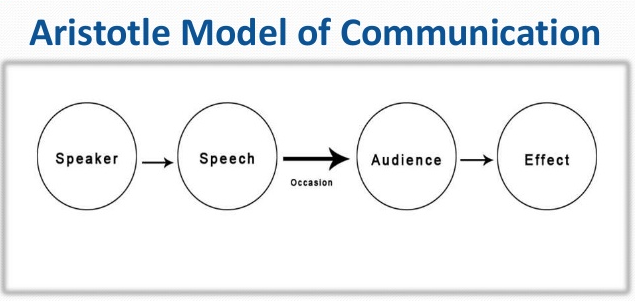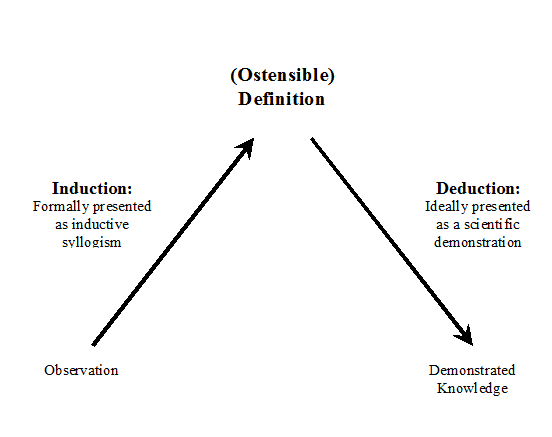He first began to develop his view of rhetoric while he was in Athens and completed his formation at his school the Lyceum. Aristotle discusses the types of political topics of deliberative rhetoric.

Aristotle S Model Of Communication By Pragya Mishra Medium
2demonstrates truth that has already been defined- dialectic is in search for the truth.

. Aristotle intended them to enumerate everything that can be expressed without composition or structure thus anything. Aristotles proofs have a double. Aristotle defines rhetoric as the art of discovering the means of persuasion available for any occasion RT P30.
Which of these proofs is most important to you when listening. A 81k text-only version is available for download. His popular writings were written for a general audience and modeled after Platos dialogues.
Section 1 45k Section 2 45k Section 3 40k Download. Ethos Credibility or ethical appeal means convincing by the character. They are perhaps the single most heavily discussed of all Aristotelian notions.
What are the defining features of aristotles rhetoric and platos dialectic. Ethos Pathos Logos. Aristotle attempted to place all branches of human knowledge in systematic order.
The Greek philosopher Aristotle divided the means of persuasion appeals into three categories Ethos Pathos Logos. Among the many areas of ancient knowledge that Aristotle knew and wrote rhetoric is only one branch of them. His popular writings were written for a general audience and modeled after Platos dialogues.
Many are familiar with Aristotles rhetorical proofs. Aristotle defined rhetoric as the faculty of observing in any given case the available means of persuasion and this is never more evident than in his discussion of the rhetorical proofs. Book I 186k Book II 191k Book III 131k Download.
Deliberative judicial and demonstrative 116 my brackets. One person is speaking to many - dialectic is a one on one discussion. Aristotle first organized the art of rhetoric into three separate and definite parts or proofs.
The three parts major premise minor premise and conclusion. Aristotles types of rhetoric. In this paper I shall first discuss the criticisms of rhetoric made by Aristotles contemporaries and then elaborate Aristotles response-a response which provides a defense of rhetoric and of political life2 I In his Rhetoric Aristotle divides rhetoric into.
Aristotle defines rhetoric then describes the three main methods of persuasion. The memoranda is a collection of research materials and historical records. Aristotle then identifies the three styles of oratory.
Aristotles Metaphysics was the first major study of the subject of metaphysics - in other words an inquiry into first philosophy or wisdom. Aristotles Writings and Philosophies Aristotles writings can be categorized into three groups. From these two types of audience Aristotle extrapolates three genera of rhetorics.
Deliberative political forensic legal and epideictic ceremonial. Rhetoric is no exception. Ethos pathos and logos but oftentimes that familiarity only extends to the superficial level.
Any kind of decision-making body a group that is setting policies should engage in deliberative rhetoric or what is sometimes called policy argumentation. Aristotle identified three kinds of rhetoric with he admitted some overlap. As Aristotle said in deliberative rhetorical situations people argue about the pragmatics of the.
In Aristotles Rhetoric he divided speaking into three categories. Logos logical reasoning ethos character and pathos emotion. The work is brief enough to be divided not into books as is usual with Aristotles works but into fifteen chapters.
He further subdivides logos into example and enthymeme a form of syllogism. Things which are subject to the laws of nature things that move and change are measurable. Forensic deliberative and _____.
A major premise combines w a minor premise to lead the listener to a logical conclusion explicitly explained by the speaker deductive reasoning - can be PATRONIZING. The Categories places every object of. The Categories is a text from Aristotles Organon that enumerates all the possible kinds of things that can be the subject or the predicate of a proposition.
Rhetoric has been divided into the following sections. Within the Trivium the goal of argumentative writing is to persuade your audience that your ideas are valid or more valid than someone elses. Aristotles Writings and Philosophies Aristotles writings can be categorized into three groups.
The memoranda is a collection of research materials and historical records. Popular writings memoranda and the treatises. The five most common are finance war and peace national defense imports and.
A 373k text-only version is available for download. What are the 3 types of rhetoric. It differs from Physics which is concerned with the natural world.
For Aristotle deliberative advice is either protreptic exhortation or aprotreptic dissuasion 116. These parts were the ethos the pathos and the logos. The work is brief enough to be divided not into books as is usual with Aristotles works but into fifteen chapters.
The Categories places every object of human apprehension under one of ten categories known to medieval writers as the Latin term praedicamenta. A set of propositions that are related draw a conclusion from the major and minor premise. Categories has been divided into the following sections.
Popular writings memoranda and the treatises. The Rhetoric Aristotle divided artistic proofs into ethos pathos and logos.

Aristotle Logic Internet Encyclopedia Of Philosophy

The Tree Of Logic Logic And Critical Thinking School Of Philosophy Critical Thinking

This Is A Two Week Unit That Will Teach Students How To Analyze Rhetoric And How To Write Effective Rhetoric As Well In All T Teaching Rhetoric Teaching Tips
0 Comments